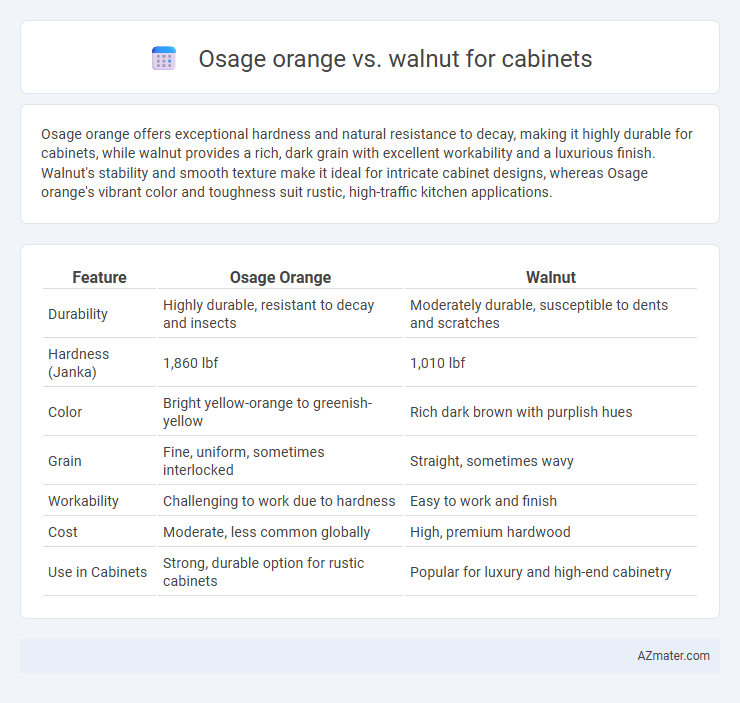Osage orange offers exceptional hardness and natural resistance to decay, making it highly durable for cabinets, while walnut provides a rich, dark grain with excellent workability and a luxurious finish. Walnut's stability and smooth texture make it ideal for intricate cabinet designs, whereas Osage orange's vibrant color and toughness suit rustic, high-traffic kitchen applications.
Table of Comparison
| Feature | Osage Orange | Walnut |
|---|---|---|
| Durability | Highly durable, resistant to decay and insects | Moderately durable, susceptible to dents and scratches |
| Hardness (Janka) | 1,860 lbf | 1,010 lbf |
| Color | Bright yellow-orange to greenish-yellow | Rich dark brown with purplish hues |
| Grain | Fine, uniform, sometimes interlocked | Straight, sometimes wavy |
| Workability | Challenging to work due to hardness | Easy to work and finish |
| Cost | Moderate, less common globally | High, premium hardwood |
| Use in Cabinets | Strong, durable option for rustic cabinets | Popular for luxury and high-end cabinetry |
Overview: Osage Orange and Walnut Wood
Osage Orange wood is highly valued for its exceptional durability, bright yellow-orange hue, and natural resistance to rot and insects, making it ideal for rustic cabinetry and specialty furniture. Walnut wood, known for its rich, dark brown color with intricate grain patterns, is a premium choice for high-end cabinets, offering both strength and a luxurious aesthetic. Both woods provide excellent workability, but Osage Orange stands out for outdoor use while Walnut excels in refined indoor applications.
Grain and Color Comparison
Osage orange features a fine, uniform grain with a distinctive, bright yellow-green to golden hue that darkens to a rich orange-brown over time, offering a unique, vibrant aesthetic for cabinets. Walnut showcases a straight to wavy grain pattern with a deep chocolate brown color accented by purples and lighter sapwood, providing a classic, luxurious appearance. The grain of Osage orange is tighter and less varied compared to the more pronounced and elaborate grain structure of walnut, influencing the final cabinet design by balancing vibrancy with elegant versatility.
Durability and Hardness
Osage orange boasts exceptional durability with a Janka hardness rating around 1,290, making it resistant to wear and ideal for high-traffic kitchen cabinets. Walnut offers a lower hardness score, approximately 1,010 on the Janka scale, but is prized for its stability and smooth finish. Both woods provide strong structural integrity, yet Osage orange offers superior resistance to dents and scratches, extending cabinet longevity in demanding environments.
Workability for Cabinet Construction
Osage orange is a dense hardwood known for its exceptional durability and resistance to wear, but it can be challenging to work with due to its hardness and tendency to blunt tools quickly. Walnut offers superior workability with its straighter grain, smoother texture, and ease of cutting, shaping, and sanding, making it a preferred choice for intricate cabinet construction. Both woods provide strong structural integrity, but walnut's easier machining results in faster production and finer finishes for custom cabinetry.
Resistance to Decay and Pests
Osage orange exhibits exceptional resistance to decay and pests due to its dense, tight grain and natural insect-repellent oils, making it highly durable for cabinets in humid or pest-prone environments. Walnut, while prized for its rich color and smooth texture, offers moderate resistance but is more susceptible to fungal decay and insect damage without proper treatment. Choosing Osage orange ensures longer-lasting cabinetry with minimal maintenance, especially in challenging conditions.
Aesthetic Appeal and Design Versatility
Osage orange offers a distinctive vibrant yellow to greenish hue that darkens to rich orange-brown, enhancing cabinet aesthetics with a unique, warm glow, while walnut provides a classic, deep chocolate brown color prized for its elegant and timeless appearance. The intricate grain patterns of Osage orange lend a bold, rustic charm ideal for contemporary and rustic cabinet designs, whereas walnut's smooth, straight grain delivers exceptional versatility suitable for both traditional and modern interiors. Both woods respond well to finishes, but walnut's ability to take stains evenly makes it a preferred choice for versatile color customization in cabinetry.
Cost and Availability
Osage orange wood is generally less expensive and more readily available in certain regions of the United States, making it a cost-effective choice for cabinet construction. Walnut, prized for its rich color and durability, tends to be significantly more expensive and harder to source, often impacting project budgets and timelines. Choosing between Osage orange and walnut for cabinets often depends on balancing budget constraints against the desired aesthetic and availability in local markets.
Finishing and Maintenance Needs
Osage orange wood exhibits a dense grain and vibrant yellow-green hue that responds well to oil-based finishes, enhancing its natural durability and resistances, but it requires consistent maintenance to prevent surface dullness. Walnut offers a smoother grain and deep chocolate brown tone that accepts stains and lacquer finishes uniformly, demanding less frequent upkeep due to its naturally stable oils and resistance to wear. Both woods benefit from periodic cleaning and refinishing; however, Osage orange needs more attentive sealing to maintain its vivid color and prevent moisture damage compared to walnut's comparatively lower maintenance profile.
Environmental Impact and Sustainability
Osage orange cabinets offer superior sustainability due to the tree's rapid growth and carbon sequestration capacity, reducing deforestation pressures compared to walnut. Walnut, although highly durable and prized for its rich grain, is slower growing, often sourced from mature forests, raising concerns about habitat disruption and carbon release. Choosing Osage orange supports environmentally responsible forestry practices and lowers the carbon footprint of cabinetry projects.
Best Applications: Choosing the Right Wood
Osage orange, known for its exceptional density and vibrant yellow-orange hue, is ideal for striking accent cabinets and furniture requiring high durability. Walnut offers rich, dark tones and smooth grain patterns, making it perfect for elegant, fine cabinetry in traditional or modern interiors. Selecting between Osage orange and walnut depends on desired aesthetics and usage, with Osage orange excelling in heavy-wear environments and walnut favored for its refined appearance.

Infographic: Osage orange vs Walnut for Cabinet
 azmater.com
azmater.com